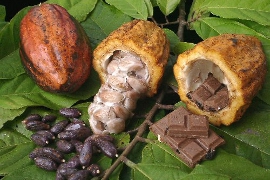In the global ranking of cocoa-producing countries, the Dominican Republic ranks first in the production and export of this product. These exports are mainly made to markets in Europe and the United States.
Over 50% of the volume of cocoa exported is organic. There are some 805,000 hectares used for organic crops in the country.
Organic cocoa first began to be grown in the Dominican Republic in the 1980s. Planting takes place on land that is totally agro-ecological, with no use being made of herbicides or chemical fertilizer. Other semi-processed foods obtained include organic cocoa liqueur, cocoa butter, cocoa powder and chocolate.
In the Dominican Republic, cocoa is one of the country’s four traditional export crops, and its relevance to the economy can be seen in terms of the hundreds of jobs it generates, its contribution to Gross Domestic Product (GDP), the protection of the environment and the country’s projection onto international markets, among other contributions.
The Dominican Republic has been included among the select group of countries recognized as producers of gourmet cocoa.
“The Cocoa Route”
The “Cocoa Route” consists of a visit to the organic cocoa plantations in the Eastern Region of the Dominican Republic. During the visit, an explanation is provided of the entire production process, including planting, harvesting, fermentation, as well as the steps for preparation of the wines, jams, chocolate and other products derived from the fruit.
The route is also known as the “Chocolate Tour” and takes about two and a half hours to complete. It is a unique experience for visitors, because in addition to learning about the cocoa production processes, they can enjoy Dominican flora and fauna, as the tour includes a visit to the Crane Sanctuary.
The tourist cocoa route was established in 2008 by the Eastern Association of Cocoa Producers. The project, first known as the “Chocolate Tour,” was originally created for school and university students, as well as for all lovers of nature and agricultural activities. The project has since provided the region with an international dimension. It now involves farmers and cultural promoters.
Aims of the initiative include identification, promotion and communication of the cultural routes with a cocoa connection in Latin America and the Caribbean, and developing awareness and appreciation of the cultural diversity linked to its collection, cultivation, production and consumption.
The plan seeks the integrated development of cocoa-growing regions to safeguard and manage their cultural heritage, thus improving the living conditions of the population dependent on its harvest.
One of the great advantages of the project is that it helps to promote interdisciplinary projects with links to the cocoa route and its influences and implications from historical, cultural, economic and social perspectives, in addition to fostering interest and solidarity in relation to the heritage shared by the different peoples and nations of the Americas.
For further information, visit: http://www.rutadelcacao.org/

